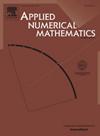关于阶数 α∈ (1,2) 的分数微分方程解的分离
IF 2.2
2区 数学
Q1 MATHEMATICS, APPLIED
引用次数: 0
摘要
给定卡普托型分数微分方程为 ,我们考虑该方程在不同初始条件下的两个不同解。在这一框架下,我们讨论......差值的非上下限。主要重点在于描述这些界限如何与相关初值的差值相关联。本文章由计算机程序翻译,如有差异,请以英文原文为准。
On the separation of solutions to fractional differential equations of order α ∈ (1,2)
Given the Caputo-type fractional differential equation with , we consider two distinct solutions to this equation subject to different sets of initial conditions. In this framework, we discuss nontrivial upper and lower bounds for the difference for . The main emphasis is on describing how such bounds are related to the differences of the associated initial values.
求助全文
通过发布文献求助,成功后即可免费获取论文全文。
去求助
来源期刊

Applied Numerical Mathematics
数学-应用数学
CiteScore
5.60
自引率
7.10%
发文量
225
审稿时长
7.2 months
期刊介绍:
The purpose of the journal is to provide a forum for the publication of high quality research and tutorial papers in computational mathematics. In addition to the traditional issues and problems in numerical analysis, the journal also publishes papers describing relevant applications in such fields as physics, fluid dynamics, engineering and other branches of applied science with a computational mathematics component. The journal strives to be flexible in the type of papers it publishes and their format. Equally desirable are:
(i) Full papers, which should be complete and relatively self-contained original contributions with an introduction that can be understood by the broad computational mathematics community. Both rigorous and heuristic styles are acceptable. Of particular interest are papers about new areas of research, in which other than strictly mathematical arguments may be important in establishing a basis for further developments.
(ii) Tutorial review papers, covering some of the important issues in Numerical Mathematics, Scientific Computing and their Applications. The journal will occasionally publish contributions which are larger than the usual format for regular papers.
(iii) Short notes, which present specific new results and techniques in a brief communication.
 求助内容:
求助内容: 应助结果提醒方式:
应助结果提醒方式:


